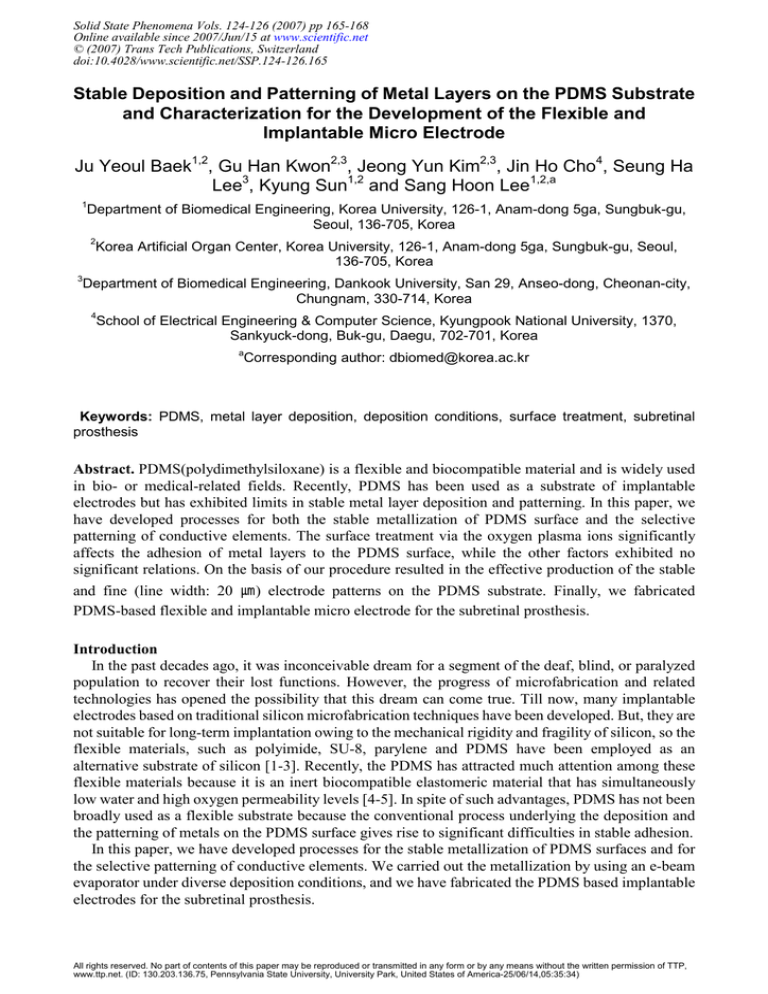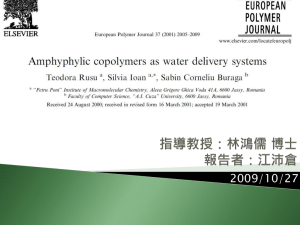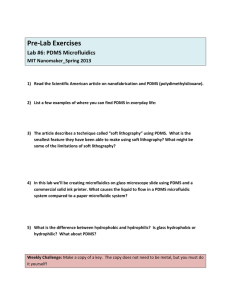
Solid State Phenomena Vols. 124-126 (2007) pp 165-168
Online available since 2007/Jun/15 at www.scientific.net
© (2007) Trans Tech Publications, Switzerland
doi:10.4028/www.scientific.net/SSP.124-126.165
Stable Deposition and Patterning of Metal Layers on the PDMS Substrate
and Characterization for the Development of the Flexible and
Implantable Micro Electrode
Ju Yeoul Baek1,2, Gu Han Kwon2,3, Jeong Yun Kim2,3, Jin Ho Cho4, Seung Ha
Lee3, Kyung Sun1,2 and Sang Hoon Lee1,2,a
1
Department of Biomedical Engineering, Korea University, 126-1, Anam-dong 5ga, Sungbuk-gu,
Seoul, 136-705, Korea
2
Korea Artificial Organ Center, Korea University, 126-1, Anam-dong 5ga, Sungbuk-gu, Seoul,
136-705, Korea
3
Department of Biomedical Engineering, Dankook University, San 29, Anseo-dong, Cheonan-city,
Chungnam, 330-714, Korea
4
School of Electrical Engineering & Computer Science, Kyungpook National University, 1370,
Sankyuck-dong, Buk-gu, Daegu, 702-701, Korea
a
Corresponding author: dbiomed@korea.ac.kr
Keywords: PDMS, metal layer deposition, deposition conditions, surface treatment, subretinal
prosthesis
Abstract. PDMS(polydimethylsiloxane) is a flexible and biocompatible material and is widely used
in bio- or medical-related fields. Recently, PDMS has been used as a substrate of implantable
electrodes but has exhibited limits in stable metal layer deposition and patterning. In this paper, we
have developed processes for both the stable metallization of PDMS surface and the selective
patterning of conductive elements. The surface treatment via the oxygen plasma ions significantly
affects the adhesion of metal layers to the PDMS surface, while the other factors exhibited no
significant relations. On the basis of our procedure resulted in the effective production of the stable
and fine (line width: 20 ) electrode patterns on the PDMS substrate. Finally, we fabricated
PDMS-based flexible and implantable micro electrode for the subretinal prosthesis.
Introduction
In the past decades ago, it was inconceivable dream for a segment of the deaf, blind, or paralyzed
population to recover their lost functions. However, the progress of microfabrication and related
technologies has opened the possibility that this dream can come true. Till now, many implantable
electrodes based on traditional silicon microfabrication techniques have been developed. But, they are
not suitable for long-term implantation owing to the mechanical rigidity and fragility of silicon, so the
flexible materials, such as polyimide, SU-8, parylene and PDMS have been employed as an
alternative substrate of silicon [1-3]. Recently, the PDMS has attracted much attention among these
flexible materials because it is an inert biocompatible elastomeric material that has simultaneously
low water and high oxygen permeability levels [4-5]. In spite of such advantages, PDMS has not been
broadly used as a flexible substrate because the conventional process underlying the deposition and
the patterning of metals on the PDMS surface gives rise to significant difficulties in stable adhesion.
In this paper, we have developed processes for the stable metallization of PDMS surfaces and for
the selective patterning of conductive elements. We carried out the metallization by using an e-beam
evaporator under diverse deposition conditions, and we have fabricated the PDMS based implantable
electrodes for the subretinal prosthesis.
All rights reserved. No part of contents of this paper may be reproduced or transmitted in any form or by any means without the written permission of TTP,
www.ttp.net. (ID: 130.203.136.75, Pennsylvania State University, University Park, United States of America-25/06/14,05:35:34)
166
Advances in Nanomaterials and Processing
Experimental Procedure
Fabrication Process. The fabrication of the PDMS substrate derived from the spin-coating method.
On the 3 inch silicon wafer, the 10:1 mixture of the PDMS prepolymer and the curing agent (Sylgard
184 silicone elastomer kit, Dow Corning, Midland, MI) was poured and spin-coated (speed: 150 rpm)
for 30 seconds and baked for 2 hours in the vacuum chamber at 120 C. Then the PDMS sheet with a
thickness of 150 was created on the wafer. We treated the surface of the PDMS layer by exposing
oxygen plasma ion for several tenths of a second. Onto this modified PDMS surface, we deposited Ti
and Au layers and patterned these metal layers by the procedure as demonstrated in Figure 1 and the
deposition conditions are summarized in Table 1.
Table 1. Deposition conditions.
Parameter
Condition
less then 1.5 10-6 torr
Vacuum
Deposition rate of Ti
0.5 /s ~ 3 /s
Thickness of Ti
Parameter
E-beam focusing size
3 E-beam power
Voltage
7.5
Current
0 ~ 100
50 ~ 300
Deposition rate of Au
Thickness of Au
0.5 /s ~ 3 /s
500 ~ 2000
Condition
Source to substrate distance
40
Substrate Temp.
Non heated
PDMS Layer
Gold Layer
Titanium Layer
(b-1
Si Wafer
(a)
Tape
PDMS
(b-2
Ti/Au Patterns
AZ5214
(b)
Press
2 Kgf/min.
100 Steel Disk
(b-3
Lift Upward
Photo-Sensitize
d
Region
UV Light
(b-4
Photomas
(a)
(c)
(b)
Fig. 2. (a) Schematic of metal patterned adhesion
test layer for the tape test. (b) The process of the
tape test, (b-1) 100 rectangular patterns on the
PDMS, (b-2) attachment of scotch tape, (b-3)
(d)
pressing with constant force (2 Kgf/cm2), (b-4)
detachment of scotch tape and enumeration of the
(e)
number of separated patterns.
Fig. 1. Metal deposition and patterning process on the PDMS layer. (a) Deposition of Ti layer
(thickness: 200 Å) and Au layer (thickness: 1000 Å) by an e-beam evaporation system on the PDMS
substrate (b) Spin-coating (5000 rpm) of photo-resistor (AZ5214). (c) Photo-sensitizations of
AZ5214 by UV light with photomask. (d) Au- and Ti-etching development of the photo-sensitized
region and of the metal layers. (e) Removal of the remnant AZ5214.
Quantitative measurement of adhesion-strength. For the quantitative measurement of the
adhesion-strength, we prepared the PDMS layer (we will call ‘adhesion test layer’ afterward)
Solid State Phenomena Vols. 124-126
167
including 100 rectangular metal patterns (Ti 200 Å / Au 1,000 Å) and its schematic and dimensions
are illustrated in Figure 2(a). Onto the adhesion test layer, we attached the scotch tape (1.8 1.8 )
and pressed uniformly with a constant force (2 Kgf/cm2) for 10 minutes, as illustrated in Figure 2(b).
We detached the tape carefully and counted the number of separated patterns to measure the adhesionstrength quantitatively. The adhesion-ratio was used for the quantitative measurement of
adhesion-strength and was calculated as follows:
N − Na
Adhesion − Ratio( AR) = b
(1)
× 100(%)
Nb
where is the number of patterns and where is the number of detached patterns from the PDMS surface.
Results and Discussion
Adhesion-strength to the surface roughness. The plasma treatment of polymer surfaces to
uniformly modify these surfaces without affecting the bulk properties has been widely employed [6].
Figure 3 illustrates the resulting curve of the roughness change according to the change-of-exposure
duration (0, 15, 30, and 60 seconds) and the corresponding AFM images are shown in Figure 3.
Before the plasma treatment, the surface was very smooth, and the mean roughness was about 1 nm.
At 15 seconds’ exposure, the mean roughness increased to 12.5 nm. At 30 seconds, the roughness
showed the maximum value, and afterward, the roughness decreased. We conjectured that at 30
seconds, the surface was fully attacked by the oxygen plasma, and the sharp peaks started to smooth
out afterward. Such roughness is caused by ion bombardment, and the rough surface is advantageous
in that it holds a metal layer more strongly than would a smooth surface, particularly as the area of the
contacting surface between the metal layer and the PDMS surface increases. We e-beam evaporated
Au and Ti layers on the plasma treated surface and patterned metal layers as shown in Figure 2(a), and
we measured the adhesion-ratio via the tape test. In Figure 4, the relation between adhesion-ratio and
surface roughness is plotted. The adhesiveness-to-the-metal layer of the rough PDMS surface (plasma
treated) is stronger than that of the smooth PDMS surface (non-treated). This result indicates that
plasma treatment enhances the adhesion-strength of metal layer to the PDMS surface significantly.
Adhesion-Ratio
100
80
60
40
20
0
0
5
10
15
20
Roughness (nm)
Fig. 3. Roughness change of the PDMS
surface according to the plasma exposure
duration.
Fig. 4. Adhesion-strength relative to surface
roughness.
Example of metal pattern and fabricated subretinal prosthesis. Figure 5(a) shows the one
electrode pattern on the PDMS substrate, and Figure 5(b) demonstrates the detailed image of
electrode patterns (the image in the dotted circle in Figure 5(a)). The line width in this figure is 20 ,
and the patterns are very clear, and adhesion-strength were similar with those of patterns on the test
168
Advances in Nanomaterials and Processing
layers. Figure 5(c) demonstrates the shapes and dimensions of designed micro electrode for the
subretinal prosthesis, and Figure 5(d) is successfully fabricated PDMS based flexible and implantable
micro electrode for the subretinal prosthesis after through packaging and gold electroplating process.
6 mm
(a)
20 Unit (mm)
(b)
(c)
(d)
Fig. 5 (a) Example of electrode pattern following the proposed process. (b) The zoomed image of
the dotted circle. (c) The shapes and dimensions of designed micro electrode. (d) PDMS-based
flexible and implantable micro electrode for the subretinal prosthesis after gold electroplating.
Conclusions
In this paper, we e-beam evaporated metal layers on the PDMS substrate and generated metal
patterns successfully. The plasma treatment of the PDMS surface significantly affects the
adhesion–strength of metal layers. Finally, we fabricated PDMS-based flexible and implantable
micro electrode for the subretinal prosthesis. Researchers shall broadly apply this process to the
diverse implantable and flexible electrodes that correspond to prostheses for missed functions.
Acknowledgment
This study was supported by a grant of the Korea Health 21 R&D Project, Ministry of Health &
Welfare, Republic of Korea. ( 02-PJ3-PG6-EV10-0001)
References
[1] K. Lee, J. He, A. Singh, S. Massia, G. Ehteshami, B. Kim and G. Raupp; J. Micromech. Microeng.,
Vol. 14 (2004), p. 32
[2] P. J. Rousche, D. S. Pellinen, D. P. Pivin, J. C. Williams, R. J. Vetter, D. R. Kipke; IEEE Trans.
Biomed. Eng., Vol. 48 (2001), P.361
[3] M. Maghribi, J. Hamilton, D. Polla, K. Rose, T. Wilson, P. Krulevitch; Proc. of the Second
Annual International IEEE-EMBS Special Topic Conference on Microtechnologies in Medicine
& Biology, Madison, Wisconsin, USA, May 2-4, (2002), P.80
[4] A. Folch, M. Toner; Biotechnol. Prog., Vol. 14 (1998), p.388
[5] V. I. Sevastianov; Trends Biomater. Artif. Organs., Vol. 15 (2002), P.20
[6] M. C. Coen, R. Lehmann, P. Groening, L. Schlapbach; Appl. Surf. Sci., Vol. 207 (2003), p.276
Advances in Nanomaterials and Processing
10.4028/www.scientific.net/SSP.124-126
Stable Deposition and Patterning of Metal Layers on the PDMS Substrate and Characterization for the
Development of the Flexible and Implantable Micro Electrode
10.4028/www.scientific.net/SSP.124-126.165
DOI References
[2] P. J. Rousche, D. S. Pellinen, D. P. Pivin, J. C. Williams, R. J. Vetter, D. R. Kipke; IEEE Trans. iomed.
Eng., Vol. 48 (2001), P.361
doi:10.1109/10.914800
[4] A. Folch, M. Toner; Biotechnol. Prog., Vol. 14 (1998), p.388
doi:10.1021/bp980037b
[1] K. Lee, J. He, A. Singh, S. Massia, G. Ehteshami, B. Kim and G. Raupp; J. Micromech. Microeng., Vol.
14 (2004), p. 32
doi:10.1088/0960-1317/14/1/305
[2] P. J. Rousche, D. S. Pellinen, D. P. Pivin, J. C. Williams, R. J. Vetter, D. R. Kipke; IEEE Trans. Biomed.
Eng., Vol. 48 (2001), P.361
doi:10.1109/10.914800



